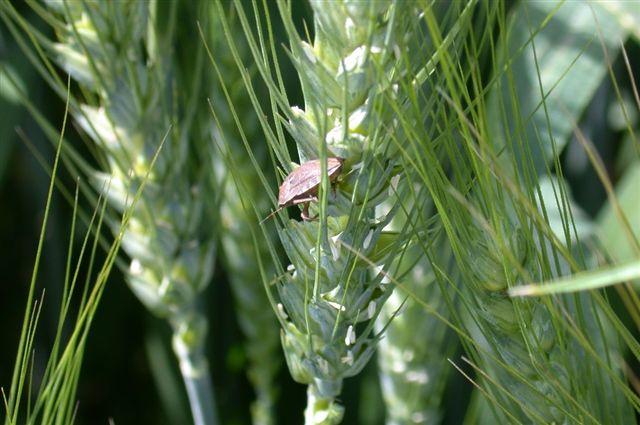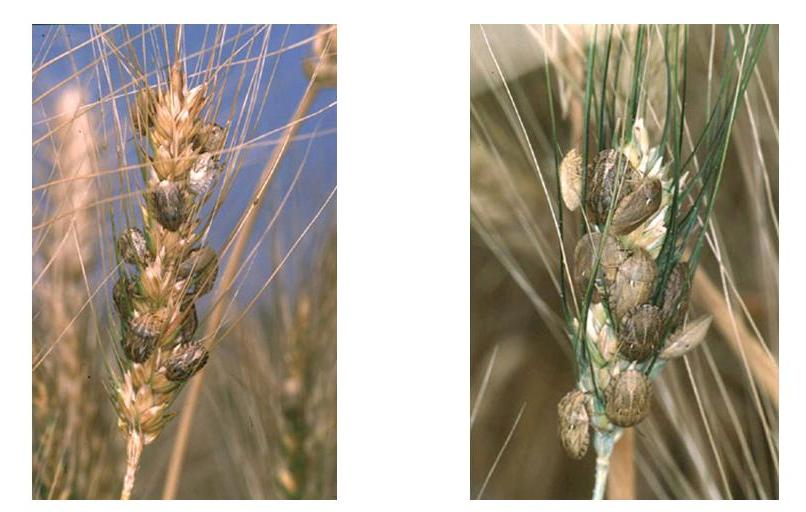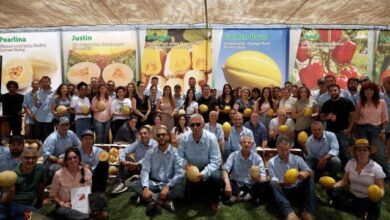Management of Sunn Pest for Better Wheat Quality and Stable Profitability
Research in integrated pest management (IPM) against the sunn pest in wheat
M.Kostyukovsky, et al.

management of sunn pest eurygaster integriceps put for the improvement of wheat quality in israel
sunn pest eurygaster integriceps put. (heteroptera: scutelleridae) is well known as a serious limiting factor for production of wheat grain with strong gluten in the near and middle east, eastern and southern europe and north africa. bug damaged wheat contains enzymes which degrade gluten proteins, cause rapid relaxation of dough andresult in the production of bread with poor volume and texture.
in israel, the economical importance of the bug was considered an endemic. recently it was found that a significant part of the grain yield was characterized by a low gluten index (less than 40%), which is an acceptable parameter for gluten quality evaluation. the gluten quality depends on many factors, such as wheat variety, soil and weather conditions and agro-technical measures. one of the most serious factors affecting the gluten qualityissunn pest. the object of this study was to develop the integrated pest management (ipm) against the sunn pest, resulting in the improvement of wheat quality in israel and stable profitability for wheat growers.
.jpg)
during the past several years, systemic observation and experiments were conducted for studies on sunn pest biology, phenology and harmfulness under local conditions in order to develop the integrated sunn pest management. preferable for bug hibernation biotopes and sites were found. as a rule, diapaused adults winter under the fallen leaves of eucalyptus, acacia, oak, cypress and pine trees. the strong influence of sunn pest infestation on the gluten quality was found. when the percentage of damaged kernels in commercial samples of wheat from the ashdod area was increased from 0.8% to 11%, the gluten index, as a parameter of gluten quality, was reduced from 60% to 20%, which made the wheat unacceptable for mills. total destruction of gluten was recorded in the field experiments conducted in kibbutz beery (western negev) when the sunn pest population and the kernel damage levels were very high: 58 nymphs/m2 and 44% respectively. in contrast, on the treated part of the same field the numbers of the bug were reduced to 0-0.6/m2, the gluten index was very high: 83-94% (variety bet hashita) (table).

the role of genetic, agrotechnical and ecological factors which affect the gluten quality, increases in cases of limited bug population and low levels of kernel damage
it was also found that the variety of wheat is of high importance for the level of the gluten index and the degree of e. integriceps damage.

the current study showed the effects of the spring wheat varieties’ growth in israel on the level of gluten index and on the degree of e. integriceps damage. most of the wheat variety tests, arial, bar nir, bet hashita, bsbl-4, negev, rotem, ruta, zahir and others, were determined as “strong” gluten cultivars. athir, galil and shoham were classified as having “weak” gluten. gedera, nirit, ram and yuval were in the middle of the scale. the sunn pest causes significantly less damage to the gluten quality in so-called strong varieties compared to the weaker ones. moreover, varieties bar nir and bsbl-4 were found to have tolerance to e. integriceps damage. for example, in the variety test in kibbutz beery, the bug damage of 4% to the variety bet hashita decreased the gluten index from 92% (at zero infestation by treatment) to 54%. in contrast, 4.5% kernel damage in the untreated variety bar nir caused a negligible change in the gluten index, from 99% (zero infestation, treated) to 85%.

the strategy for sunn pest management is based on the use of varieties with strong gluten and, if necessary, on the rational use of chemical treatment. therefore, the tactics of chemical control should include treatment timing, the economical threshold of harmfulness, localization of treatment and the choice of a suitable, preferred ecologically friendly, insecticide. it was shown that in most of cases, one treatment against nymphs at the phenological period, from the end of the kernel filling to the wax stage of wheat ripening, is sufficient to eliminate the bug population, drastically reduce the percentage of damaged kernels and significantly improve the gluten index value (table ).
one of the ipm concept postulates is to treat the pest when its population is greater than the threshold of harmfulness. the threshold is influenced by many factors, such as weather and agro-technical conditions, the correlation between the wheat and the bug phenology, the basic variety quality, the physiological status of the bug and others. our findings allow us to establish the following tentative thresholds for sunn pest control: against overwintering adults 1-2/m2, against nymphs (3-5 instars) 2-4/m2.
the choice of an effective and ecologically friendly insecticide is important to meet today’s very strict demands for chemical control. it was found that some pyrethroids, such as talstar, titan, baythroid and cymbush were effective against sunn pest and improved the gluten index of the treated wheat. igr rimon prevents the emergence of adults and significantly decreases bug damage.
in conclusion, sunn pest management should be based on the use of varieties with strong gluten. if necessary, one treatment with pyrethroid or igr, at the phenological period, from the end of the kernel filling to the wax stage of wheat ripening, is sufficient to diminish the sunn pest population, drastically reduce the percentage of damaged kernels, and significantly improve the gluten quality.
authors: m. kostyukovsky,*1, a. trostanetsky1, m. menasherov1, g. yasinov1, u. naftaliyahy2, d. zohar2, s. kitain2, and y. melamed2
1dept. of food sciences, aro, the volcani center, p.o.box 6, bet dagan, 50250, israel. *corresponding author (e-mail: inspect@volcani.agri.gov.il)
2the agricultural extension services, p.o.box 28, bet dagan, 50250, israel
(published in israel agriculture, 2010)




